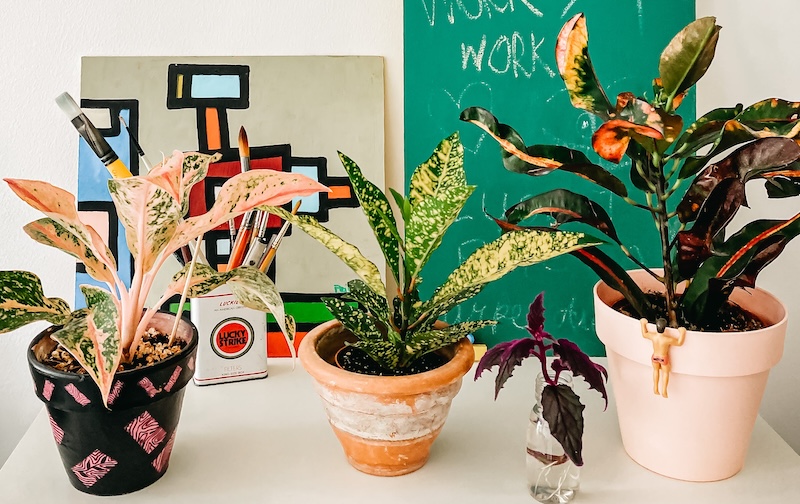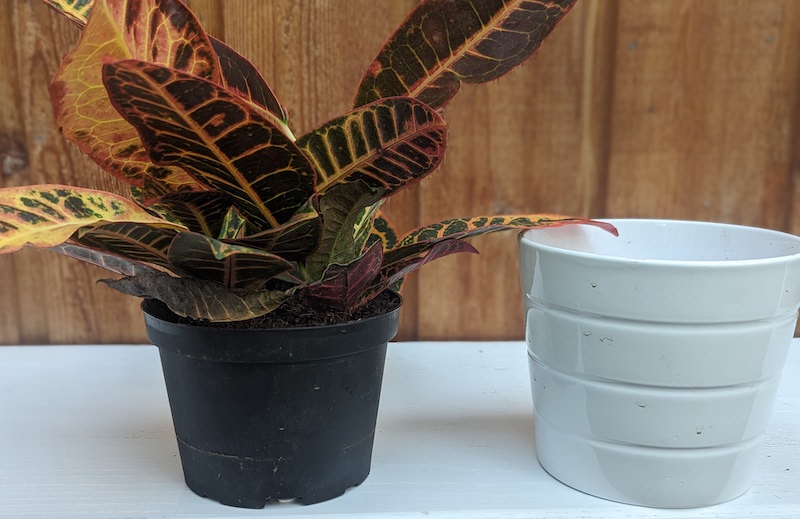Croton will need to be potted and repotted yearly to accommodate regular seasonal growth. Tropical plants such as Croton, do not like to grow in large pots where there is more soil than roots. A pot that is 1-2 inches larger than the existing rootball is perfect. Croton plants that may have been overwatered will also benefit from repotting into a new container with plenty of bottom drainage and fresh potting mix. When bringing a new plant home, it is a good idea to repot it into fresh soil so that you can inspect the root system for any possible problems. Often Crotons will have outgrown the containers they were grown in at the nursery.

Potting Croton
Step 1 - Choose a decorative container that has adequate bottom drainage and pair it with a plastic plant saucer to protect furnishings indoors. If the plant will be growing outside, do not use a bottom saucer on the pot.
Step 2 - Fill the bottom third of the pot with a potting mix.
Step 3 - Gently remove the plant from its nursery pot and tease loose any roots that are circling the rootball.
Step 4 - Place the root ball in the pot so that it is about 1 inch below the top of the container.
Step 5 - Firm potting mix around the root ball, filling in all of the large air pockets.
Step 6 - Water the plant until liquid drains from the drainage holes. Add more potting mix to the top of the pot if the level is low.
Step 7 - If using a slow-release fertilizer, apply it at the recommended rate to the top of the potting soil and lightly scratch it into the top layer.
Repotting Croton
Croton will need annual repotting during the first 3-4 years until it reaches maturity. Choose pots that are 1 size larger for repotting. Selecting too large of a pot could trap too much moisture around the roots. When your Croton has reached its mature size, only repot when roots appear from the bottom drainage holes or the top of the planter. Yearly refreshing of the potting mix will keep your mature Croton growing vigorously. Scrape off the top 2-3 inches of soil and replace with fresh potting mix. As you water the plant, nutrients from the fresh soil will work their way deeper into the existing soil.

Best Soil For Croton
Croton prefers well-drained, slightly acidic that stays evenly moist. A commercial potting soil is generally fine as long as it drains well. For a good balance of moisture retention and drainage, try mixing a slightly acidic potting soil with fine orchid potting bark. Fox Farm makes a potting soil called Ocean Forest Potting Soil MIx that is ready to use for acid-loving plants. It has a pH of 6.3 - 6.8 and is lightweight and free draining.
Croton Drainage
Use a container that has plenty of drainage holes in the bottom. This will allow excess water to drain out during watering, keeping the roots from sitting in moisture for long periods of time. Use a heavy-duty plastic saucer under pots that are indoors. This keeps furniture safe from excess water and is easy to empty after watering. Sometimes a more decorative cache pot is used to disguise a plastic sleeve or liner and helps to protect furniture and carpet from getting wet. Make sure to empty any standing water from the cache pot soon after watering. If the decorative pot is too big to easily empty, a turkey baster works to remove excess water.
 |
Author Robbin Small - Published 11-13-2023 |
